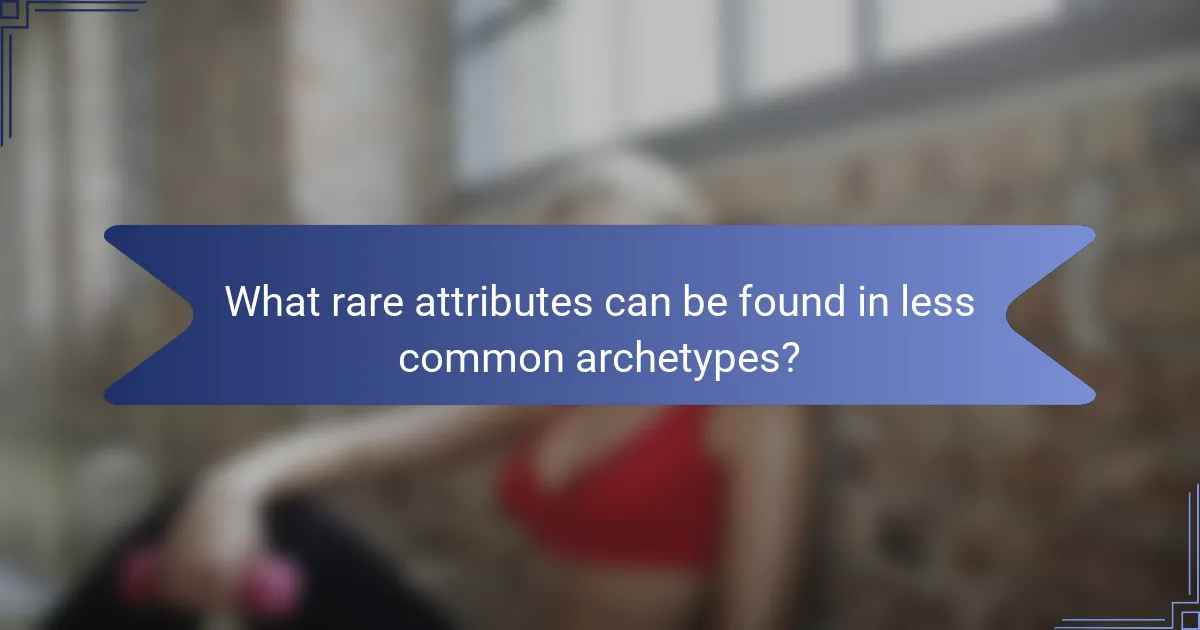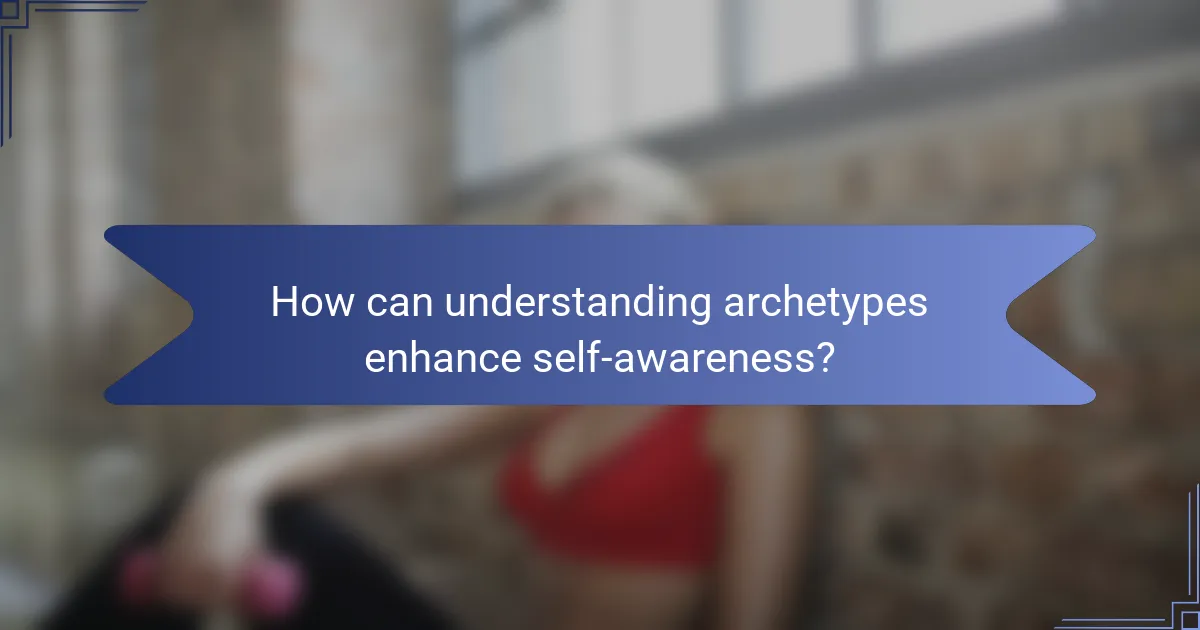Understanding Jungian archetypes can enhance self-discovery by revealing personal motivations and behaviours. This article explores the universal symbols in the collective unconscious, key archetypes like the Hero and Shadow, and their role in personal growth. It also examines unique attributes of specific archetypes and their application in therapeutic practices. Engaging with these concepts fosters deeper self-awareness and transformative experiences.

What are Jungian Archetypes?
Jungian archetypes are universal symbols and patterns in the collective unconscious that influence self-discovery. They help individuals understand their motivations and behaviours. Key archetypes include the Hero, the Shadow, and the Anima/Animus. These archetypes guide personal growth by providing insights into one’s psyche and fostering deeper self-awareness. Recognising these patterns can lead to transformative experiences and a better understanding of oneself.
How do archetypes influence personal identity?
Jungian archetypes significantly shape personal identity by providing a framework for self-discovery. They represent universal patterns that influence how individuals perceive themselves and interact with the world. By recognising these archetypes, people can gain insights into their motivations, behaviours, and relationships. For instance, the Hero archetype may inspire someone to embrace challenges, while the Caregiver archetype might drive nurturing behaviours. Understanding these influences allows for deeper self-awareness and personal growth.
What are the primary categories of archetypes?
The primary categories of Jungian archetypes include the Self, the Shadow, the Anima/Animus, and the Persona. Each archetype represents fundamental human experiences and influences personal development. The Self embodies wholeness and integration, while the Shadow represents the unconscious aspects of the personality. The Anima/Animus reflects the inner feminine/masculine, and the Persona is the social mask presented to the world. Understanding these archetypes can enhance self-discovery and personal growth.
What roles do the Hero and the Shadow play?
The Hero represents the pursuit of growth and self-actualisation, while the Shadow embodies the repressed aspects of the self. Together, they drive the journey of self-discovery by highlighting inner conflicts and potential transformations. The Hero’s journey often involves overcoming challenges, revealing strengths, and achieving personal goals. In contrast, the Shadow confronts fears, insecurities, and hidden desires, prompting introspection and healing. This dynamic interplay fosters a deeper understanding of one’s identity, ultimately leading to greater self-awareness and psychological balance.
How do the Anima and Animus contribute to self-discovery?
The Anima and Animus facilitate self-discovery by integrating unconscious elements into consciousness. They represent the inner feminine and masculine aspects within individuals, guiding personal growth. Engaging with these archetypes fosters balance and enhances emotional awareness. This process can lead to a deeper understanding of one’s identity and purpose.

What are the universal attributes of Jungian Archetypes?
Jungian archetypes share universal attributes that influence self-discovery. These attributes include the collective unconscious, persona, shadow, anima/animus, and archetypal symbols. The collective unconscious represents shared human experiences, while the persona reflects the social mask we wear. The shadow embodies repressed aspects of the self, and anima/animus represents the inner feminine or masculine. Archetypal symbols serve as manifestations of these concepts, guiding individuals toward deeper self-awareness and personal growth.
How do archetypes manifest in everyday life?
Jungian archetypes manifest in everyday life through behaviours, roles, and narratives that shape our experiences. For example, the Hero archetype appears in individuals who face challenges with courage, while the Caregiver archetype influences those who prioritise nurturing others. These archetypes guide personal growth and self-discovery by reflecting innate patterns of behaviour. As a result, understanding these archetypes can enhance self-awareness and interpersonal relationships.
What psychological benefits do archetypes provide?
Jungian archetypes offer significant psychological benefits, including enhanced self-awareness and personal growth. They provide frameworks for understanding behaviours, emotions, and motivations. By identifying with archetypes, individuals can gain insights into their own identity and life journey. This process fosters a deeper connection to the collective unconscious, promoting healing and transformation. Additionally, archetypes can improve interpersonal relationships by fostering empathy and understanding of others’ perspectives.

What unique attributes do specific archetypes possess?
Specific archetypes possess unique attributes that guide individual behaviours and motivations. The Hero archetype exemplifies courage and determination, while the Mentor embodies wisdom and guidance. The Rebel showcases a strong desire for change, and the Caregiver highlights nurturing qualities. Each archetype influences self-discovery by revealing intrinsic values and personal strengths.
How does the Trickster archetype challenge traditional views?
The Trickster archetype challenges traditional views by subverting norms and conventions. It embodies chaos and unpredictability, prompting individuals to question established beliefs. This archetype encourages exploration of the self and societal structures, revealing deeper truths through humour and paradox. By embracing the Trickster, one can foster creativity and resilience, ultimately leading to personal growth and transformation.
What insights can the Wise Old Man offer in self-discovery?
The Wise Old Man archetype provides insights into self-discovery by encouraging introspection and wisdom. This figure symbolizes guidance, knowledge, and the importance of inner reflection. By embodying the qualities of patience and understanding, individuals can explore their thoughts and emotions more deeply. Engaging with this archetype can lead to greater self-awareness and clarity in personal goals. The Wise Old Man’s influence highlights the value of mentorship and the lessons learned from life experiences.

What rare attributes can be found in less common archetypes?
Less common archetypes may exhibit rare attributes that enhance self-discovery. Examples include the Alchemist’s transformative vision, the Caregiver’s deep empathy, and the Rebel’s unconventional wisdom. These traits can lead to unique insights into personal growth and identity.
How does the Orphan archetype illustrate feelings of abandonment?
The Orphan archetype illustrates feelings of abandonment through its portrayal of isolation and longing for connection. This archetype embodies the universal experience of feeling neglected or rejected, often leading to struggles with self-worth and trust. It emphasises the importance of belonging and the emotional scars left by abandonment. As a result, individuals may seek out relationships or communities to fill the void left by these early experiences. The Orphan’s journey often leads to resilience and personal growth, highlighting the transformative power of overcoming feelings of abandonment.
What can we learn from the Caregiver archetype in our relationships?
The Caregiver archetype teaches us the importance of empathy and nurturing in relationships. By embodying compassion, we foster deeper connections and understanding. This archetype emphasises selflessness, which can lead to healthier dynamics. Acknowledging the needs of others strengthens bonds and promotes emotional support.

How can understanding archetypes enhance self-awareness?
Understanding archetypes enhances self-awareness by providing insights into personal motivations and behaviours. Jungian archetypes serve as models that help individuals identify patterns in their thoughts and actions. Recognising these patterns fosters deeper self-reflection and personal growth. For instance, identifying oneself as the “Hero” archetype may inspire courage and resilience, while the “Caregiver” archetype might highlight nurturing tendencies. This awareness can lead to improved relationships and decision-making. Ultimately, understanding archetypes empowers individuals to embrace their true selves and navigate life’s challenges more effectively.
What methods can be used to identify personal archetypes?
To identify personal archetypes, methods include self-reflection, personality assessments, and storytelling analysis. Self-reflection allows individuals to explore their motivations and behaviours. Personality assessments, such as the Myers-Briggs Type Indicator, categorise traits aligning with archetypes. Storytelling analysis examines narratives one resonates with, revealing underlying archetypes. These methods facilitate deeper self-discovery, highlighting unique attributes that define personal identity.
How can one integrate archetypal insights into daily life?
Integrating Jungian archetypal insights into daily life enhances self-awareness and personal growth. Begin by identifying your dominant archetypes through reflection or assessments.
Next, observe how these archetypes influence your behaviours and decisions. For example, if you resonate with the Hero archetype, seek challenges that foster bravery and resilience.
Incorporate archetypal themes into daily routines, such as journaling about experiences that align with your archetypes. This practice deepens understanding and encourages alignment with your authentic self.
Lastly, engage in discussions or workshops focused on archetypes to share insights and gain new perspectives, enhancing your journey of self-discovery.

What are the practical applications of Jungian Archetypes in therapy?
Jungian archetypes are used in therapy to facilitate self-discovery and personal growth. They help individuals identify and understand their unconscious motivations and behaviours, leading to greater self-awareness.
Therapists often employ archetypes as tools to explore clients’ narratives, enabling them to recognise patterns in their lives. For instance, the Hero archetype can guide clients in overcoming challenges, while the Shadow archetype helps in confronting repressed aspects of the self.
Additionally, the use of archetypes fosters empathy and connection between therapist and client, as shared human experiences are highlighted. This approach can lead to transformative insights and emotional healing, making it a valuable aspect of therapeutic practice.
How can therapists utilize archetypes in their practice?
Therapists can utilize archetypes to enhance self-discovery in clients. By identifying and integrating archetypes, therapists facilitate deeper understanding of personal narratives and behaviours. This approach fosters emotional healing and encourages clients to explore their identities. Archetypes can also serve as tools for role-playing and visualization, aiding in the therapeutic process. Moreover, therapists can guide clients in recognising archetypal patterns in their lives, promoting self-awareness and growth.
What are common mistakes when applying archetypal theories?
Common mistakes when applying archetypal theories include oversimplifying complex personalities, misinterpreting archetypes, and ignoring individual differences. These errors can lead to inaccurate self-assessments and hinder personal growth. Additionally, failing to consider cultural contexts may distort the understanding of archetypes, as they can vary significantly across different societies. Lastly, relying too heavily on archetypes can result in a rigid view of identity, limiting the exploration of one’s unique traits.

What expert insights can enhance the journey of self-discovery?
Understanding Jungian archetypes can significantly enhance self-discovery by providing insights into personal motivations and behaviours. These archetypes, such as the Hero, the Shadow, and the Anima, represent universal patterns that shape individual experiences.
Engaging with these archetypes allows individuals to identify their strengths and weaknesses, fostering a deeper understanding of their identities. For instance, recognising one’s Shadow can lead to personal growth by addressing repressed traits.
Additionally, exploring these archetypes facilitates a connection with collective unconsciousness, bridging personal experiences with shared human narratives. This connection can inspire transformative journeys, guiding individuals toward authenticity and fulfilment.
Incorporating reflective practices, such as journaling or creative expression, can deepen the exploration of these archetypes. By actively engaging with one’s inner landscape, individuals can uncover hidden potentials and navigate their paths to self-discovery more effectively.
What best practices should one follow when exploring archetypes?
To explore Jungian archetypes effectively, one should follow these best practices: start with self-reflection to identify personal archetypes, engage in creative expression to manifest these archetypes, and study their cultural significance for deeper understanding. Additionally, consider journaling to track insights and progress. This approach enhances self-discovery through the lens of archetypal influences.